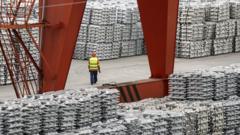President Trump's recent directive to impose a 25% tariff on steel and aluminum imports evoked immediate backlash from leaders in Canada and Europe, who pledged reciprocal actions to protect their industries. While the tariffs aim to boost domestic production, economic analysts express skepticism over potential job creation and the overall efficacy of such measures.
Trump Imposes New Steel and Aluminum Tariffs, Fuels International Tensions

Trump Imposes New Steel and Aluminum Tariffs, Fuels International Tensions
With a unilateral tariff of 25%, Trump’s move faces fierce resistance from Canada and Europe, raising concerns over trade wars.
Following a bold declaration, President Donald Trump has outlined a sweeping 25% tariff on all steel and aluminium imported into the United States, dramatically affecting trade relations, especially with Canada and European nations. Asserting that "we need steel and aluminium made in America," Trump signed a proclamation scheduled to take effect on March 12. This move dismantles previous exemptions benefitting allies like Canada and the EU, prompting immediate condemnation from global leaders.
European Commission President Ursula von der Leyen stated that such tariffs would result in "firm and proportionate countermeasures," with Canada’s Prime Minister Justin Trudeau equally vowing to defend Canadian interests as tensions rise. Canadian officials have labeled the tariffs "totally unjustified," fearing significant economic repercussions, while Canadian steelmakers urged their government to respond swiftly against the U.S. measures.
Market responses have been mixed, with U.S. steel stocks seeing a surge amid anticipation of heightened protectionist measures. However, the broader financial implications suggest uncertainty, reflecting market unease over whether Trump’s aggressive stance represents a genuine policy shift or merely a negotiative ploy. Analysts are drawing parallels to submissions made during Trump's previous term when tariff exemptions were frequently negotiated.
Notable economists emphasize the potential pitfalls of this approach, warning that increased production costs for American industries reliant on these materials could negate any anticipated job gains. Trump has indicated a robust vision for U.S. trade policy, proposing additional tariffs on sectors ranging from pharmaceuticals to technology in the future.
As the administration moves forward, the overarching question remains: will these tariffs act as a catalyst for a broader trade conflict or serve as a strategic bargaining tool? The coming weeks will be critical in determining the trajectory of U.S. trade relations under this new policy landscape.






















